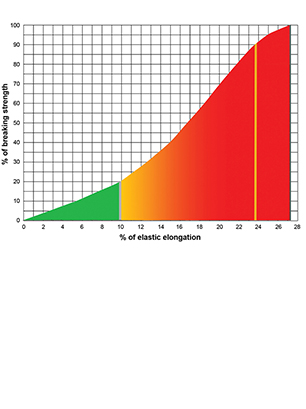Nylon Brait™
Rope Characteristics
Nylon Brait combines braiding technology with plaited rope optimizing the best of both rope styles. Nylon Brait’s most outstanding feature is its high energy absorption, which comes from a combination of the very long yarn path and stranditure developed especially to maximize energy absorption.
Nylon Brait can absorb (or mitigate) greater amounts of dynamic energy than 3-stranded or braided rope structures with less damage. Brait’s energy absorption also keeps the corresponding loads on attachment points smaller since the rope does more work internally. Brait is easily spliced and the spliced rope delivers 100% of the ropes advertised strength.
Breaking Strengths
| Diameter (Inches) |
Weight (Lbs/100f) |
Average Spliced Break Strength* (Lbs) |
Minimum Spliced Break Strength* (Lbs) |
Maximum Working Load 5:1** (Lbs) |
|---|---|---|---|---|
| 3/8 | 3.8 | 4,000 | 3,600 | 800 |
| 1/2 | 6.1 | 8,300 | 7,470 | 1,660 |
| 17/32 | 6.4 | 9,200 | 8,280 | 1,840 |
| 5/8 | 9.4 | 12,200 | 10,980 | 2,440 |
| 21/32 | 9.6 | 12,900 | 11,610 | 2,580 |
| 11/16 | 11.0 | 15,000 | 13,500 | 3,000 |
| 3/4 | 14.0 | 17,000 | 15,300 | 3,400 |
| 7/8 | 19.0 | 22,000 | 19,800 | 4,400 |
| 1 | 23.7 | 27,000 | 24,300 | 5,400 |
| 1-1/8 | 30.5 | 34,750 | 31,275 | 6,950 |
| 1-1/4 | 35.6 | 40,500 | 36,450 | 8,100 |
| 1-1/2 | 49.8 | 56,700 | 51,030 | 11,340 |
| 1-5/8 | 59.5 | 67,700 | 60,930 | 13,540 |
| 1-3/4 | 74.0 | 84,700 | 76,230 | 16,940 |
| * Knots and abrupt bends significantly reduce the strength of all ropes and lower maximum working load. ** Working load is based on static or moderately dyanmic lifting/pulling operations. Instantaneous changes in load, up or down, in excess or 10% of the rope’s related working load constitute hazardous shock load and would void the normal working-load recommendation. Consult Yale Cordage for guidelines for working loads and the safe use of rope. |
||||
| Diameter (mm) |
Weight (Kg/100m) |
Average Spliced Break Strength* (kg) |
Minimum Spliced Break Strength* (kg) |
Maximum Working Load 5:1** (kg) |
|---|---|---|---|---|
| 10 | 5.7 | 1,800 | 1,620 | 360 |
| 13 | 9.1 | 3,750 | 3,375 | 750 |
| 13 | 9.5 | 4,150 | 3,735 | 830 |
| 16 | 14.0 | 5,500 | 4,950 | 1,100 |
| 17 | 14.3 | 5,850 | 5,265 | 1,170 |
| 17 | 16.4 | 6,800 | 6,120 | 1,360 |
| 19 | 20.8 | 7,700 | 6,930 | 1,540 |
| 22 | 28.3 | 10,000 | 9,000 | 2,000 |
| 25 | 35.3 | 12,250 | 11,025 | 2,450 |
| 29 | 45.4 | 15,750 | 14,175 | 3,150 |
| 32 | 53.0 | 18,350 | 16,515 | 3,670 |
| 38 | 74.2 | 25,700 | 23,130 | 5,140 |
| 41 | 88.6 | 30,700 | 27,630 | 6,140 |
| 44 | 110.2 | 38,450 | 34,605 | 7,690 |
| * Knots and abrupt bends significantly reduce the strength of all ropes and lower maximum working load. ** Working load is based on static or moderately dyanmic lifting/pulling operations. Instantaneous changes in load, up or down, in excess or 10% of the rope’s related working load constitute hazardous shock load and would void the normal working-load recommendation. Consult Yale Cordage for guidelines for working loads and the safe use of rope. |
||||
Rope Details
Rope Benefits
|
Elastic ElongationThe coloured area under the curve represents the rope’s energy absorption capability.
 |



